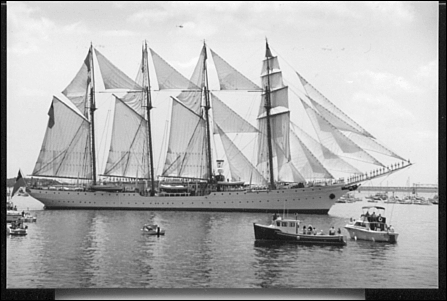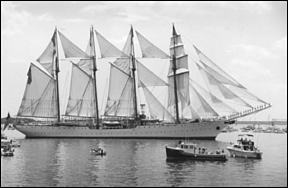Making Basic Cleanups
| The basic cleanup should be your first step when working on any picture. Study the picture. Ask yourself some questions:
Here's a photo I just scanned for these examples (see Figure 24.1). It was shot about eight or nine years ago when the Tall Ships came to Boston. This is the training ship Esmeralda, a four-masted schooner from Chile. Figure 24.1. At close to 370 feet long, I barely got her in the frame. As you can see, this is definitely in need of some cleaning up. First, I'll crop out the black edges from the scanner. It looks pretty straight, so we won't mess with rotating it. However, if you look carefully , you'll see that the black speck between the two middle masts is a helicopter. It's not big enough to see clearly, so we'll take it out with the Clone Stamp. Removing Small Objects with the Clone Stamp ToolWhen small objects wander into your photographs uninvited, use the Clone Stamp to get rid of them. The Clone Stamp works by copying the color of nearby pixels onto the pixels you drag over with the tool. So to fix my photo, I used the tool to copy the colors of the sky nearby, and to paint with those colors over the image of the helicopter, thereby removing it. To use the Clone Stamp tool, zoom in on the area you're trying to fix, and then select the tool from the toolbox. Choose a brush from the drop-down list. Typically, a soft-edged brush is best, because it will soften the effect and make it less obvious. Next, select a brush size. Choose a brush that's large enough to cover the telephone wire, tree branch, or stray dog you want to remove, but not too big. Select a blending mode and opacity. For this kind of repair, I usually leave these set to Normal, 100%. Turn on the Aligned option if you want to copy colors from nearby pixels. Turn it off if you want to copy the colors in one area of the image to several different places. If you want to "mix your paint" using colors from all layers , turn on the Use All Layers option. After setting options, press Command-Alt and click in the image to take a sample of the colors there. Then click and drag to begin painting. Short strokes are best. If the Aligned option is turned on, you'll paint with colors taken from a spot that's roughly the same distance from the mouse pointer as the original spot and the place where you first began painting. The spot where your colors are coming from is marked with a big X . If the Aligned option is not on, your paint color will come from the place where you first clicked to take a sample. To get rid of the offending helicopter, I zoomed in, clicked the Clone Stamp tool, selected a relatively small soft brush, sampled some sky, and used one short stroke to remove the helicopter from the sky. Removing Small Objects with Copy and PasteThe cluster of little boats just at the stern of the ship, under her flag, is a distraction. Fortunately, it looks like there's enough water at the bottom-left edge to cover them up. For this, I'll start by copying some water and pasting it into a new layer over the boats. When you want to cover something in an area of your image that should look like another area of the image, why not simply copy the good section and paste it over the bad? You can fix large areas with a single click using this method. Of course, you'll have to soften the edges of the pasted area, but that's not a problem. To remove those distracting boats from the left side of my photo, I copied a small piece of water from below them, then pasted it back into my image. Elements automatically creates a new layer for the pasted data, which is placed exactly above the spot on the image where I copied it. This makes the pasted area a bit tough to see, so I temporarily hid the image layer by clicking its eye icon in the Layers palette. Then I used the Move tool to position the patch as carefully as I could. I repeated this process a few times, because I needed several different patches of water to cover the boats. When I was done, I merged all the layers by selecting Layer, Merge Visible. Then I used the Clone Stamp to sample the correct water color nearby, and paint it over the edges of my patches, hiding them. Follow the horizon when you drag with the Clone Stamp, in order to imitate the ripples in the water (see Figure 24.2). Figure 24.2. Zoom in so you can see what you're doing. With my careful copying and pasting, and some help from the Clone Stamp, the little boats are gone in no time. Now I'm ready to go on to color corrections, lighting changes, and any other major changes. I might try applying a watercolor filter (which makes the photo appear as if it were painted with watercolors), Chalk & Charcoal (which simulates that artistic effect), or Spatter (which spreads out the colors in a spattered pattern). On the other hand, I might just leave it as it is, which isn't bad. See this in color in the color section. |
EAN: 2147483647
Pages: 349
- Assessing Business-IT Alignment Maturity
- Linking the IT Balanced Scorecard to the Business Objectives at a Major Canadian Financial Group
- A View on Knowledge Management: Utilizing a Balanced Scorecard Methodology for Analyzing Knowledge Metrics
- Governance in IT Outsourcing Partnerships
- The Evolution of IT Governance at NB Power
- Chapter I e-Search: A Conceptual Framework of Online Consumer Behavior
- Chapter V Consumer Complaint Behavior in the Online Environment
- Chapter VI Web Site Quality and Usability in E-Commerce
- Chapter IX Extrinsic Plus Intrinsic Human Factors Influencing the Web Usage
- Chapter XI User Satisfaction with Web Portals: An Empirical Study

